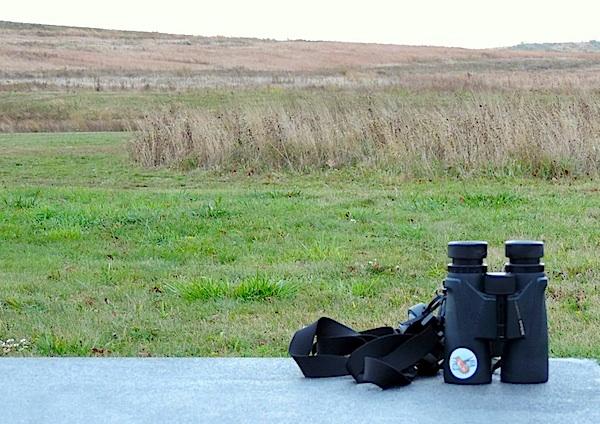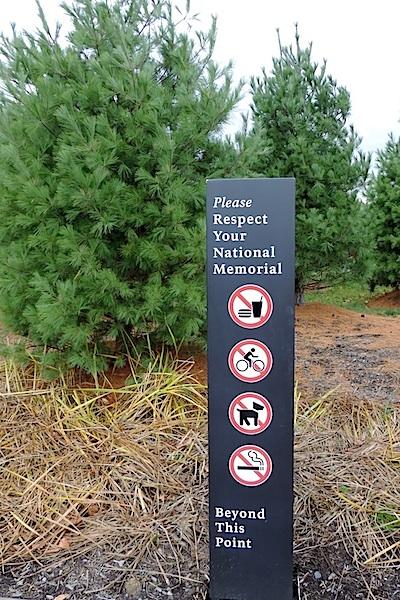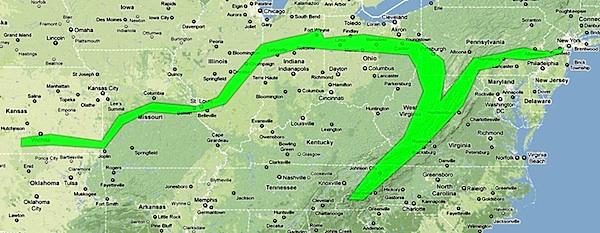
The quiet fields at Flight 93 National Memorial draw a good number of birds/Kirby Adams
I generally don't have a problem wondering whether or not it's a good time to bird. If no other duty calls, I've got binoculars in hand. I've certainly had birding as a top priority on every visit to a national park. Yet, on a dreary day in Pennsylvania last week, I visited a national park and wasn't sure if wanted to bird, or even if I should consider it.
Thirteen autumns ago, the now infamous Flight 93 flew directly over my home and crashed into a field just a few miles away. By the time the Flight 93 National Memorial had been built, I had moved to the Midwest. Subsequent trips home never included time to visit the site, but last week I found myself driving out to the holy birding ground of Cape May, New Jersey. Planning to stop in to see my family on the way back, I exited the interstate and climbed over the mountains on the Lincoln Highway. Flight 93 wasn't on my mind at all with the birds of the Atlantic Coast still consuming my thoughts. And then I saw the sign for the memorial and turned suddenly onto the entrance road without a second thought.
The roughly four-mile drive from the highway to the parking area passes some ponds that had assorted ducks in them, but I didn't bother stopping. At the parking area it was windy and overcast, a threat of drizzle in the air. This October day was nothing like the bright and calm morning of September 11, 2001, that we all remember so well.
About to get out of the car, I was struck with a moment of indecision utterly unfamiliar to me. Should I take my binoculars? I've birded sewage ponds where no sane person goes. I've birded the woods near elementary schools, where a man with binoculars is about as suspicious as a thing can be. I've gotten some of my best birds in cemeteries. None of that has ever seemed inappropriate. For some reason, this was different. I asked myself if I would think it in poor taste to look for birds at the USS Arizona Memorial. Having never been there, I don't know what I would do.
I grabbed the binoculars, tucking them discreetly under an arm, and began the walk to the memorial and impact site. There were no more than a dozen other visitors on the walkway. The atmosphere was quiet and respectful, but not solemn. People smiled for photographs. A senior citizen chuckled at her struggles to use her iPad to shoot video. A pair of chickadees landed on the boulder that marks the spot the plane hit the ground and disintegrated, killing 44 people, four of them terrorists determined to disrupt and degrade the way of life in the United States. Glancing from the lady with the iPad to the chickadees frolicking on the boulder, I'd say those four men failed miserably.

Kirby Adams photo.
The Flight 93 Memorial lies in an area where identification of chickadees can be tricky business. The Black-capped Chickadees of the North meet with the southern Carolina Chickadees in a narrow band across the eastern United States. This contact zone stretches from southern Kansas to St. Louis, north of Indianapolis and Columbus, shoots down the mountains to the Great Smokies, then back up toward New York City. The zone is no more than about 20 miles wide in some areas, but it can cause a lot of trouble. The two chickadees, already nearly identical in appearance, hybridize within and near the contact zone. Without hearing a bird vocalize in some way, it can be impossible to distinguish the Black-caps from the Carolinas from the hybrids.
I suspected these birds were Black-capped Chickadees, as the park is in the ridge-lined highlands directly north of where the dreaded chickadee contact zone dips south through the Appalachians. It's usually all Black-capped Chickadees up here. Before long, the chickadees became irritated with a passing Blue Jay and started giving their alarm call, the famous chick-a-dee-dee-dee. The tempo of this call was not rapid enough to be a Carolina Chickadee, good enough to confirm them as Black-caps in my book.
Was I wrong to be identifying chickadees at the impact site of this tragedy? I don't think so, but others might judge differently. I think 40 of the departed and their familes would approve of folks enjoying nature peacefully at the memorial. The other four men on that plane wouldn't want anyone to spend a tranquil moment watching birds above their final resting place, and that's all the more reason to do so in my opinion. They wanted destruction. What they got was a grandmother accidentally taking a video of her own face instead of the memorial wall, and a guy trying to figure out what two tiny birds were.
On the way out I checked the ponds and exchanged a nod and smile with a ranger. Nothing but Canada Geese, Mallards, and a Great Blue Heron could be seen. Just the usual residents of any pond in central Pennsylvania doing what they do on any fall day. Life goes on.

Black-capped chickadees and Carolina chickadees mingle in middle America, as this Google map shows in tracking their movements.



Comments
I think you definitely did the right thing.